|
|
OTHER ASGARDIANS
|
|
|
Amora, the Enchantress
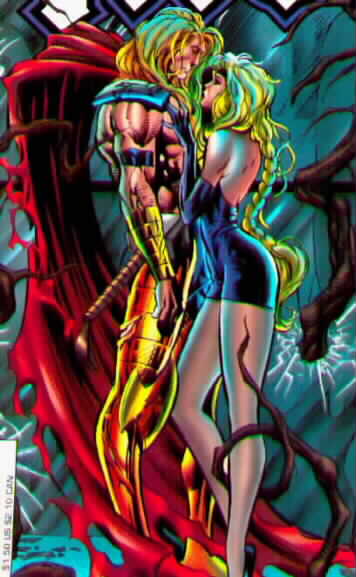
|
Amora has traditionally been an enemy to Thor and Asgard. For years, she has constantly tried to seduce Thor in an attempt to win him, but his love for Sif and disdain for Amora's evil ways were too great. Recently, however, Amora and Thor have become lovers. Both have been banned from Asgard (for different reasons) and have become closer since Amora saved Thor's life when he became mortal. The long-term ramifications of this relationship are unknown, since neither has been in contact with Asgard.
The Marvel Handbook (1986) says:
Amora was born somewhere in Asgard, her parentage unknown. While still in adolescence, she ran away to the land of the Norns and apprenticed herself to Karnilla, one of the most powerful sorceresses in all the Asgardian dimension. There she studied all the basic arts of Asgardian magic until Karnilla expelled here for being too undisciplined. She picked up further sorcerous skills from seducing other Asgardian mages and wizards.
Centuries ago, Amora enlisted Brunnhilda, leader of Odin's Valkyries, in her plans of conquest. However, Brunnhilda soon became aware of Amora's immoral ends, and sought to end their partnership. Amora then used her magic to ent rap Brunnhilda within a mystical crystal of souls. Only recently has Brunnhilda been freed from Amora's spell.
The Enchantress seduced Skurge the Executioner into assisting her in many of her schemes over the years. But while the Executioner was so infatuated with the Enchantress that he would do anything for her, she continually withh eld her favors from him to keep him in thrall.
In her first encounter with Thor after he gained his human identity of Don Blake, she attempted unsuccessfully to seduce Blake, and then ordered the Executioner to dispose of Jane Foster, the mortal woman Thor then loved. Thor saved Foster and defeated both the Enchantress and Executioner.
In the following years the Enchantress has also allied herself with Loki, Baron Heinrich Zemo, the Mandarin, and Arkon in pursuit of her goals of power and vengeance upon her enemies. Her most frequent adversaries during these y ears have been Thor and the Avengers. She used one of Zemo's machines to transform one of the Baron's mercenaries into the first Power Man.
The Enchantress's crimes have earned her Odin's wrath, and she has suffered exile from Asgard in the past. However, she and the Executioner both came to Asgard's aid in its recent war with Surtur. In retaliation for her younge r sister Lorelei's refusal to join her in battling Surtur, the Enchantress used sorcery to make Lorelei fall in love with Loki. Despite her recent heroism, the Enchantress basically remains an opportunist seeking her own ends. Finally tiring of the Enchan tress's contemptuous treatment of him, the Executioner nobly sacrificed his life on a mission with Thor into Hel, the realm of the goddess Hela. The Enchantress's reaction to Skurge's death is as yet unrecorded.
|
|
Balder the Brave
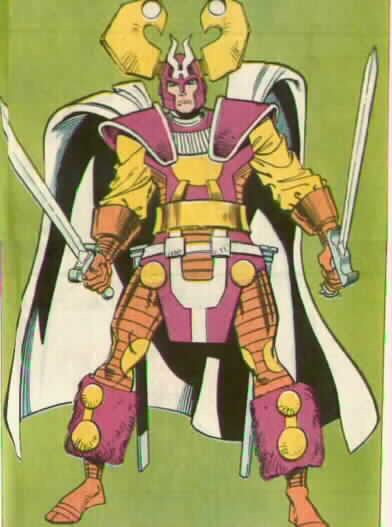
|
God of Light
Briefly - The fairest of the gods, Thor's staunchest companion, and favorite son of Frigga. Invulnerable to virtually all injury due to a promise extracted by his mother, Balder need fear only the lowly mistletoe. The death of Balder is one of the prophesied signs of Ragnarok.(Source- Thor: the Legend)
The Marvel Handbook (1986) says:
Due to his many heroic deeds over the ages, Balder has long been regarded as Asgard's noblest god and its greatest warrior next to the thunder god Thor, who has long been Balder's closest friend. Balder has been unsuccessfully sought as a lover by the sorceress Karnilla the Norn Queen
Because of the prophecies that Balder's death would help trigger the coming of Ragnarok, the destruction of Asgard and its inhabitants, Odin, ruler of Asgard, commanded his wife Frigga to make Balder invulnerable to harm. Frigga cast spells that would protect Balder from harm by any living or inanimate thing while he was in the Asgardian dimension. (The legends describe her as extracting promises from all of these things not to harm Balder, as if they were all sentient and capable of speech.) The sole exception was mistletoe. This omission is probably not due to forgetfulness on Frigga's part, since she has not made him invulnerable to harm from mistletoe since his vulnerability became known. It is more likely that his vulnerability to mistletoe is a necessary side effect of the spells making him invulnerable to harm from other things.
Loki, the god of mischief, learned of the prophecies tying Balder's death to the coming of Ragnarok, and also learned of Balder's vulnerability to mistletoe. Seeking to bring about Ragnarok, Loki tricked the blind god Hoder into firing an arrow tipped with mistletoe wood at Balder. Balder was fatally wounded, but Odin's power prevented him from actually dying and instead kept him in a state resembling suspended animation. Nevertheless, Balder's spirit journeyed to Hel, one of the Asgardian realms of the dead. There Balder was appalled at seeing the horrors endured by the spirits of so many of those whom he had slain in battle.
Odin finally restored Balder fully to life, but Balder's hair turned white as a result of his experiences in Hel. His beloved, Nanna, sacrificed her life to save him from entrapment in marriage by Karnilla, and Balder was so distraught that he has resolved never to speak of this incident or of her again. Anguished by Nanna's death and by what he had seen in the land of the dead, Balder forswore the life of a warrior, attempted unsuccessfully to forget his misery through eating, gaining considerable weight in the process, and finally rode out into the desert,hoping to die there. Instead, Balder encountered the Norns, the three goddesses who oversee the workings of destiny. The Norns gave Balder a vision that restored his faith in the value of life and in the need for him to continue living. Balder rode back to Asgard and was sent by Odin to Karnilla to seek her aid in the Asgardians' battle against Surtur and the legions of Muspelheim. Balder was successful in this mission, and his relationship appears to have changed in the process. Balder has also returned to his normal weight through vigorous exercise.
|
|
Fandral
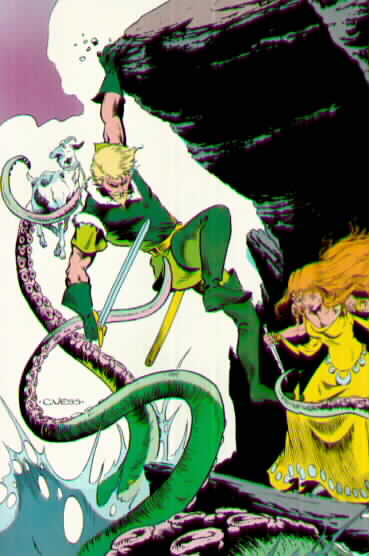
|
The Dashing
The Marvel Handbook (1986) says:
Fandral is a member of the Warriors Three, three of Asgard's most celebrated heroes. Hogun, Fandral and Volstagg are longtime friends who ususally work together as a team. Their first known mission together took place at an unknown time in the past when they joined the quest by sea led by the prince of Asgard, Thor, to discover the reason why a crack had appeared in the Odinsword (also called Oversword) of Asgard, a power object that could bring about Asgard's destruction. Hogun, Fandral, and Volstagg aided Thor in quelling a mutiny led against Thor, on this mission by his adoptive brother Loki. Since then Hogun, Fandral, and Volstagg have been Thor's friends, allies, and companions, and have aided him in numerous exploits.
In contrast with Hogun, who bears a somber demeanor, Fandral the Dashing is known for his humor, high spirits, and love of displaying his prowess with the sword in battle.
Like other Asgardians, the Warriors Three are extremely long-lived (although not immortal like the Olympian gods), superhumanly strong, immune to all terrestrial diseases, resistant to convential injury, and in possession of superhuman endurance.
|
|
Frey
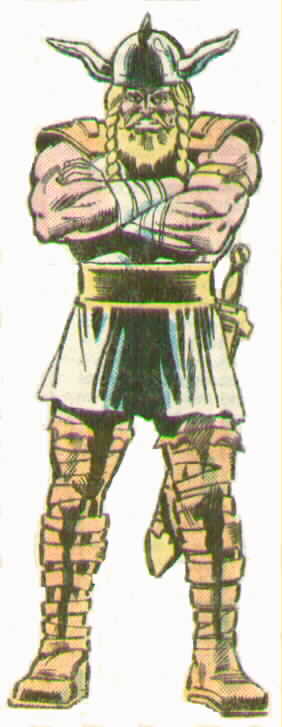
|
God of the harvest
The Marvel Handbook (1986) says:
Very little is known about Frey's life and exploits save for his role in the building of the palace of Valhalla.
|
|
Frigga
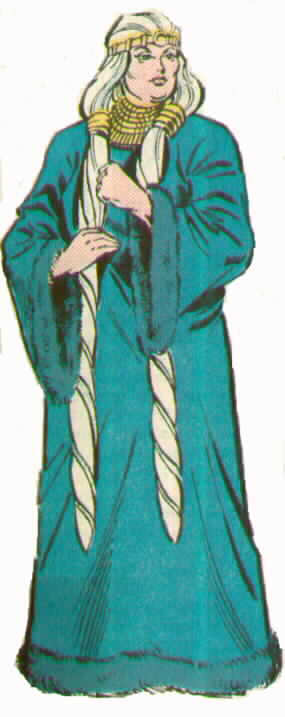
|
Queen of Asgard
Briefly - Wife of Odin, and Goddess of Marriage. Mother of Asgard's beloved Balder, but not the mighty Thor, she has still found a place for her adopted son in her heart -- she disapproved of Odin's banishment of Thor to Earth as mortal Don Blake, and was estranged from her husband for years because of it. Frigga alone knows the secret of taming Odin's rages and rousing him from his dark broodings. (Source- Thor: the Legend)
The Marvel Handbook (1986) says:
As Odin's wife, Frigga raised his son Thor, even though he was not her natural son. Frigga cast the spells to protect Balder from mortal harm. Frigga also supervised the efforts of the Asgardian goddesses to locate and train members of the Young Gods, the apprentices of the Celestials.
|
|
Heimdall
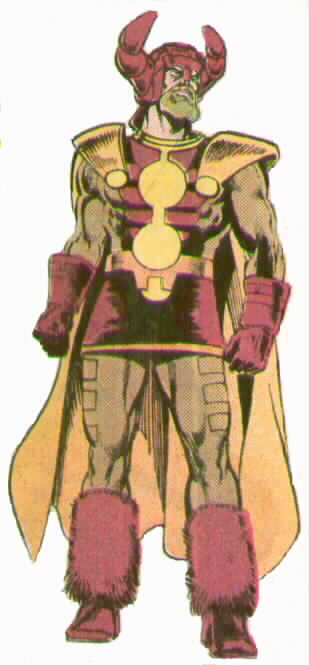
|
Sentry of Asgard
Briefly - The watchman of the Rainbow Bridge. Born of the fabled Nine Goddesses, the valiant sentinel stands guard at the entrance to Asgard, his highly acute senses alert for the slightest hint of danger, his might sword ready to defend the realm against the forces of evil. (Source- Thor: the Legend)
The Marvel Handbook (1986) says:
Renowned for his heightened perceptions, Heimdall was appointed by Odin to be sentry of the Rainbow Bridge. For millenia, Heimdall remained at his post, venturing from it but once on a mission from Odin. Now that the Bridge has been destroyed, Heimdall stands at Asgard's gates
|
|
Hermod
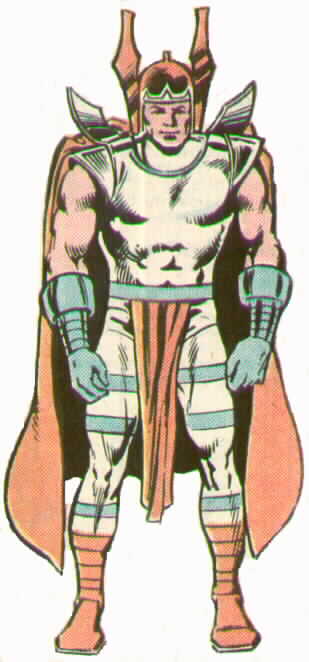
|
God of speed
Briefly - The God of Speed, and fastest of all Asgardians. One of the sons of Odin and Frigga, young Hermod is the messenger of the Asgardians. On his most celebrated mission, Odin sent him to Hel to learn the secret of reviving his brother Balder and thus staving off the day of Ragnarok. (Source- Thor: the Legend)
The Marvel Handbook (1986) says:
Very little is known of Hermod except that he is a relatively young Asgardian god. Noted for his fleetness, he is occassionally employed by Odin as a messenger. His most celebrated mission took him to Hela to learn how Balder might be revived.
|
|
Hoder
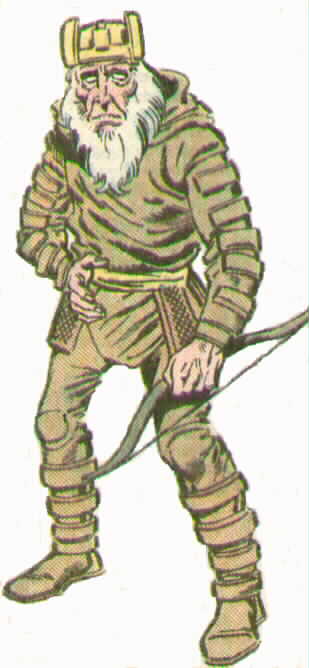
|
God of Winter
Briefly - God of Winter. Dwelling on a snow-capped peak in the Asgardian mountains, the blind hermit regulates the passage of the seasons in Asgard, and prefers the company of the elements to that of people. In the prophesies of Ragnarok, Hoder accidentally kills Balder with an arrow of mistletoe.(Source- Thor: the Legend)
The Marvel Handbook (1986) says:
Hoder is an elderly god who nearly killed Balder when Loki tricked him into shooting Balder with an arrow tipped with mistletoe wood, to which Balder was vulnerable.
|
|
Hogun
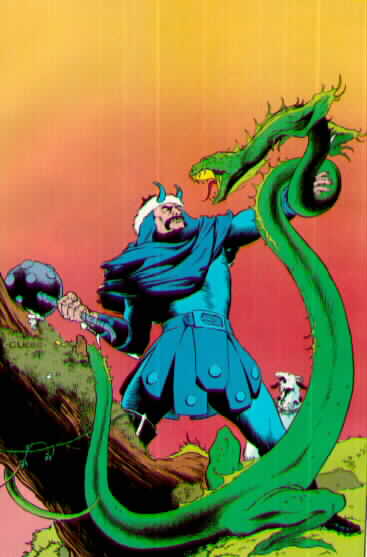
|
The Grim
The Marvel Handbook (1986) says:
Hogun is a member of the Warriors Three, three of Asgard's most celebrated heroes. Hogun, Fandral and Volstagg are longtime friends who ususally work together as a team. Their first known mission together took place at an unknown time in the past when they joined the quest by sea led by the prince of Asgard, Thor, to discover the reason why a crack had appeared in the Odinsword (also called Oversword) of Asgard, a power object that could bring about Asgard's destruction. Hogun, Fandral, and Volstagg aided Thor in quelling a mutiny led against Thor, on this mission by his adoptive brother Loki. Since then Hogun, Fandral, and Volstagg have been Thor's friends, allies, and companions, and have aided him in numerous exploits.
Hogun the Grim is not a native of Asgard, but originally came from an unnamed land elsewhere in the Asgardian dimension. Hogun's homeland was conquered by Mogul of the Mystic Mountain, but together Thor and the Warriors Three defeated Mogul and liberated Hogun's homeland.
Like other Asgardians, the Warriors Three are extremely long-lived (although not immortal like the Olympian gods), superhumanly strong, immune to all terrestrial diseases, resistant to convential injury, and in possession of superhuman endurance.
|
|
Idunn
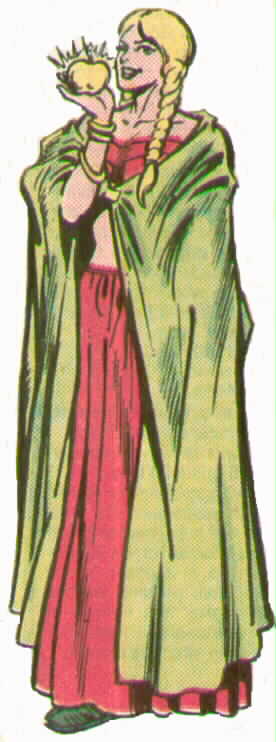
|
Goddess of immortality
The Marvel Handbook (1986) says:
Odin appointed Idunn as Keeper of the Golden Apples, whose mystical properties retard aging among the Asgardians.
|
|
Karnilla
[unfortunately unphotogenic]
In the past Karnilla has often proved to be an enemy of Asgard, and has acted in alliance with the Asgardian god of evil, Loki. However, Karnilla has long been in love with Asgard's noblest warrior, Balder the Brave. On Balder's request (on behalf of Asgard's monarch Odin), Karnilla allied herself and her army with Asgard in the recent war with Surtur. After years of resisting Karnilla's advances, Balder has finally become Karnilla's lover. Some of Balder's Asgardian friends disapprove of the relationship, regarding Karnilla as a figure of evil. Karnilla regards herself, however, as a harsh but just ruler.
Balder was called away from Nornkeep to join the Asgardian prince Thor in his mission to rescue souls of Earth human beings from Hel. During Balder's absence, Karnilla was taken prisoner by the Frost Giants of Jotunheim, who were preparing an invasion of Asgard and first intended to eliminate Asgard's allies. The Frost Giants also transformed Karnilla's subjects into stone. On his return, Balder set out to rescue Karnilla, and ultimately met with success.
|
Queen of the Norns
Briefly - Queen of the Norns. Most accomplished sorceress in all Asgard. Frequent ally of Loki. Usually an enemy of Odin and Asgard, Karnilla's love for Balder has sometimes placed her on the side of Asgard. Of all her misdeeds, perhaps there was none so heinous as her driving Balder's beloved Nanna to suicide.(Source- Thor: the Legend)
The Marvel Handbook (1986) says:
The birth and early life of Karnilla are shrouded in mystery. All that is really known is that she has long lived in Nornheim, the Asgardian province where dwell the Three Norns, the goddesses of destiny, and she has become one of the most accomplished practitioners of the arts of sorcery in the Asgardian dimension. Although Nornheim lies on the Asgardian land mass within Asgard's own dimension, and although Karnilla is apparently of the Asgardian race, she does not consider herself to be subject to Asgardian rule. Rather, Nornheim is an independent country, of which Karnilla is absolute monarch.
Karnilla lives opulently in the ancient fastness of Nornkeep, attended by her servant, the aged minor sorceress Haag, and troops of guardian demons. Although there are many demons among her subjects, Karnilla's realm is also populated by humanoid immortals, just as is Asgard proper. Karnilla's relationship to the goddesses of destiny is unknown, although they are clearly beyond her jurisdiction.
|
|
Loki
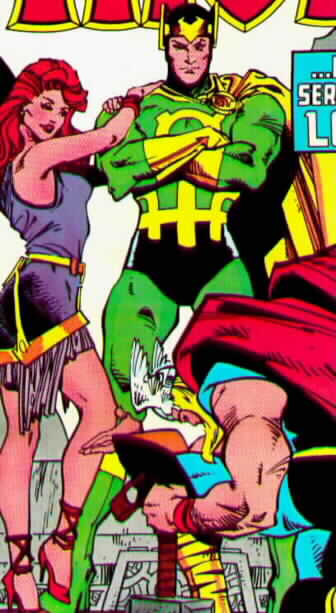
- Recently, Loki joined Thor and Odin in their battle against the demonic Surtur. Surtur intended to destroy Asgard, and Loki, whose goal is to rule Asgard, therefore felt obliged to stop him. After Odin and Surtur vanished at the end of this battle, Loki began his machinations to be named as the new ruler of Asgard. As part of his plans he magically transformed Thor into a frog, using power drawn from Surtur's abandoned sword. But Thor was returned to his normal form when the Asgardian Volstagg destroyed the engine draining power from the sword. Loki was unable to prevent the ascension of Balder to the Asgardian throne after Thor refused the throne himself.
- However, Loki is continuing his quest for supreme power in Asgard. It has been said that should the time of Ragnarok, the destruction of the Asgardian gods ever come, Loki will lead the forces of evil against Asgard.
|
Lord of Mischief, God of Evil!
Briefly - The son of two giants slain by Odin, Loki was raised among the gods and grew up to resent and despise them. At times a wily trickster, at others a ruthless mastermind plotting the overthrow of Asgard, Loki has long been his adopted brother Thor's greatest enemy.(Source- Thor: the Legend)
The Marvel Handbook (1986) says:
Loki is the son of Laufey, king of the frost giants of Jotunheim, one of the "Nine Worlds" of the Asgardian cosmology. Odin, ruler of Asgard, led his subjects in a war against the giants. Laufey was slain in battle and the giants were defeated. Surveying the spoils of war, the Asgardians discovered a small god-sized baby hidden at the giants main fortress. The infant was Loki, whom Laufey had kept hidden due to his shame over his son's diminutive size. Because Loki was the son of a king fallen in battle, Odin elected to adopt him and raise him as a son alongside his bloodson Thor, the future god of thunder.
In childhood Loki greatly resented the fact that Odin and the other Asgardians favored the young Thor, who already had a nobility of spirit and excelled in all his endeavors, over himself. As a boy Loki began studying the arts of sorcery, for which he had a natural affinity. His hatred of Thor grew, and while still a boy, Loki vowed to become the most powerful god in Asgard and to destroy Thor in order to achieve this end. After achieving adulthood Loki began making alliances with other enemies of Asgard.
As Loki grew to adulthood, his inborn propensity for mischief had begun to manifest itself, and he earned the nickname "God of Mischief." But as his deeds grew increasingly malicious, and his lust for power and vengeance became apparent, he became known as the "God of Evil." Loki attempted many times over the centuries to destroy Thor and seize the throne of Asgard for himself. Finally, Odin magically imprisoned him within a tree as punishment for his many crimes. Sometime thereafter, Thor was banished to Earth to learn humility in the mortal form of Dr. Donald Blake.
Shortly after Blake regained the ability to assume the godly form and power of Thor, Loki succeeded in freeing himself from his mystical imprisonment. There followed a long succession of clashes between Loki and Thor. Sometimes Loki battled Thor directly. On other occasions, Loki used pawns to fight Thor, some of whom he temporarily endowed with increased superhuman power, such as the Cobra and Mister Hyde. Loki is responsible for transforming "Crusher" Creel into the Absorbing Man and for the revival of the Asgardian Destroyer as an opponent for Thor. Loki has attempted to turn Odin against Thor and to steal Thor's enchanted hammer. On one occasion Loki mystically exchanged bodies with Thor. Loki has temporarily seized control of Asgard when Odin was incapacitated. However, Loki has invariably been thwarted in his bids for power and revenge by Thor.
|
|
Nanna
[no picture available yet]
|
Goddess of Beauty
Briefly - The one true love of Balder. Used as a pawn by Karnilla the Norn Queen to coerce Balder into marrying her, Nanna sacrificed her life to release Balder from his bitter vow. Though not a warrior, Nanna's heroic action earned her the right to spend her afterlife in Valhalla, the Hall of Heroes.(Source- Thor: the Legend)
|
|
Odin
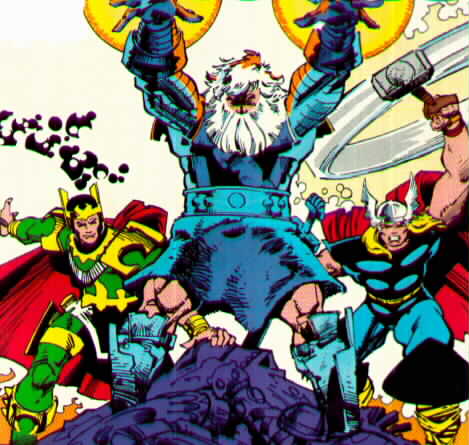
- According to the Eye, Odin commissioned the giants Fasolf and Fafnir (not to be confused with the evil monarch whom Odin once transformed into a dragon) to build him a palace in Valhalla, which is the section of Asgard where the spirits of the heroic dead dwell. In order to pay the giants, Odin, Loki, and Thor took the dwarf Alberich prisoner and forced him to surrender both his gold and the incredibly powerful mystic Ring of the Nibelung. Alberich placed a curse on the mystical Ring, which was carried off by Fafnir. According to the Eye, Odin gave Thor two different mortal incarnations, Siegmund and Siegfried, in an attempt to recover the Ring. Siegfried succeeded, but was killed by Alberich's son Hagen. Siegfried's lover Brunnhilde the Valkyrie recovered the Ring but died herself. Odin brought Thor and Brunnhilde back to life and took possession of the Ring. It is unclear how much truth, if any, there is to this story told by the Eye.
- However, all of the following is indeed true. Odin learned of the coming of the Third Host of the Celestials, alien beings of inconceivable power who had influenced the evolution of Earth's human race and intended to judge humanity's worthiness to survive when the Fourth Host came. Odin contacted Zeus, ruler of Olympian gods, during a war between the Asgardians and the Olympians to which the two rulers put a quick end. The two monarchs then met with the ruling gods of Earth's other pantheons to set a course of action. Odin, Zeus, and Vishnu of the Hindu gods confronted the Third Host, which threatened to seal off the interdimensional passages between the gods' realms adn Earth unless the gods pledged not to interfere with the Celestials' activities on Earth for a millennium. Acting on behalf of Earth's gods, Odin, Zeus, and Vishnu were forced to agree. But Odin began planning to thwart the Fourth Host, which would arrive roughly a millennium later. He constructed a suit of armor with nearly invincible powers called the Destroyer, and transformed the Ring of the Nibelung into the Destroyer's weapon, the Odinsword. Frigga and the other leading goddesses of Earth's pantheons took charge of finding Earth human beings who were as close to genetic perfection as possible over these centuries.
- In the 20th century, Odin had become greatly disturbed by his son Thor's headstrong nature. To teach him humility, Odin gave Thor a new mortal form, that of the crippled medical student Donald Blake, sending him to Earth stripped of the memory of his true identity. After Blake had become a successful physician, Odin planted within his mind the suggestion to take a vacation in Norway. There Blake stumbled into the cavern where Thor's magic hammer was left in the enchanted form of a wooden cane. Blake struck the cane against a boulder and regained his godly form while the cane again became a hammer. Eventually Thor regained his memories of his life as a god as well. Odin finally removed the spell from Thor's hammer that enabled him to change into Blake and placed the spell within the hammer he gave the alien champion Beta Ray Bill so that he could assume a non-superhumanly powerful form.
- In recent years Odin sacrificed his right eye to Mimir, the sentient Well of Wisdom in order to learn how to thwart Ragnarok, the end of Asgard. The eye itself became sentient and grew to great size in another dimension, where it told Thor stories of Odin's and his past, the truth of some of which is debatable. The eye eventually shrank and was hurled by Thor into Mimir.
- After the coming of the Fourth Host of the Celestials, Odin withdrew all of the life forces of the Asgardians except Thor's into himself. Then Odin's spirit entered the Destroyer, animating it, and Odin thus did battle with the Fourth Host. The Celestials annihilated the Destroyer, but judged in humanity's favor when Gaea presented them with twelve genetically advanced human beings, the "Young Gods". The other pantheons of Earth gods granted Thor the power to resurrect Odin, who then revived the other Asgardians. (It is possible that the Asgardians' "deaths" when the Destroyer was annihilated constituted the prophesied Ragnarok, and that the Asgardians have thus survived it.)
|
The All-Father
Briefly - The All-Father, Lord of Asgard. God of the skies, father of Thor, and wielder of the vast Odinpower from which all godly energies flow, Odin has long ruled the golden realm with wisdom and vigor, his ravens, Hugin and Munin, perched atop his shoulder, his Spear of Destiny in his guantleted hand. (Source- Thor: the Legend)
The Marvel Handbook (1986) says:
Odin was born ages ago as a member of the race of gods who would one day be called Asgardians. Odin is the grandson of Buri, the first of the Asgardian race, who is said to have emerged from beneath the ice of the extradimensional ralm of Niffleheim. Buri sired Bor, who took as his wife Bestia, one of the race of frost giants, and they had three sons, Vili, Ve, and Odin. Buri eventually gave way as the dominant member of his race to Bor, and Bor was himself eventually succeeded by his three sons. Bor's present whereabouts, if he still lives, are unknown, but Buri is still living outside the city of Asgard under the name Tiwaz.
The three brothers eventually assumed leadership of the fledgling tribe of gods. The brothers led the Asgardian warriors in a war against the frost giants of Niffleheim, and the three siblings slew the frost giants' leader Ymir. Legend has it that Odin, Vili, and Ve constructed much of the cosmos from Ymir's immense corpse, but this statement is not widely believed today. The surviving frost giants settled in the otherdimensional world of Jotunheim, yet another of the "Nine Worlds" of Asgardian cosmology, and Ymir was eventually somehow resurrected. Odin, Vili, and Ve built the city of Asgard in the realm of Asgard, which was the home of their race of gods.
Vili, Ve, and Odin finally went to explore another of the Nine Worlds, Muspelheim, which was inhabited by demons ruled by the monstrous Surtur. There the three brothers learned that Surtur intended one day to destroy the Nine Worlds with his gigantic sword, which he would ignite with the Eternal Flame of Destruction. Odin and his brothers decided that Surtur must be prevented from carrying out his plan. The three siblings magically merged into a giant of Surtur's own immense size, and in the form succeeded in shattering Surtur's sword in combat. Having returned to their individual forms, the three brothers carried off the brazier holding the Eternal Flame of Destruction. Surtur and his hordes pursued the three Asgardians to the interdimensional nexus between Asgard and Muspelheim. Odin rode through the Nexus, carrying the brazier, but his elder brothers remained behind, saying that if they accompanied Odin, then Surtur would follow the three of them wherever they went. Vile and Ve bade Odin farewell, telling him to rule Asgard wisely. Then, as Surturcame up behind them, there was a tremendous shock wave and flash of light. When Odin recovered, the Nexus to Muspelheim had vanished. Then there was a second, more powerful shock wave of energy, and the young Odin found himself in possession of his two brothers' powers. Thus Odin now possessed the "Odin-Power", which consisted of his own original energy powers combined with those that had belonged to Vili and Ve.
For ages, Odin ruled Asgard wisely and well. Odin's severed right eye, which at one point became sentient, once told a story alleging that Odin had lived a previous incarnation to that which he has possessed in recent times. According to the Eye, Odin in his earlier incarnation led the gods of Asgard against the combined forces of their enemies roughly two thousand years ago. Odin was killed by being devoured by the great Fenris Wolf, and Asgard was destroyed by Surtur's flames. Vili and Ve survived, as did Odin's sons Vidi and Vali. The four of them found Odin's spear, Gungnir, and holding onto it they were seemingly transformed into Odin's new incarnation. Finding the other Asgardians and their enemies now in the form of small chessmen-like figurines, Odin brought them to life. Thus the second incarnation of the gods of Asgard came about. However, this account of a previous incarnation and subsequent reincarnation of Odin and the Asgardians has been disputed, and may well be no more than a fiction created by the Eye for unknown reasons.
Odin made the Asgardian goddess Frigga his queen. But he eventually decided to sire a son whose power would combine that of Asgard and that of Earth. Hence he journeyed to Earth to mate with its patron goddess Gaea, who appeared to him in her persona of Jord. Gaea bore Odin his son Thor, whom Frigga then raised. Thor grew to be Odin's favorite son and the god of thunder.
Odin led the Asgardians in a war with the frost giants of Jotunheim in which the giants' leader Laufey was slain. Odin adopted Laufey's infant son, Loki, whose size was that of a god's, not a giant's. (Odin himself had a giant of Jotunheim as his mother.) Odin raised Loki alongside Thor, but the adult Loki would continually challenge Odin's rule.
It was Odin who created Bifrost, the Rainbow Bridge that served as a nexus between Asgard's dimension and Earth's until it was recently shattered. For centuries Odin and the Asgardians were worshipped by the Norsemen and Germans (who called him Wotan) on Earth.
|
|
Sif
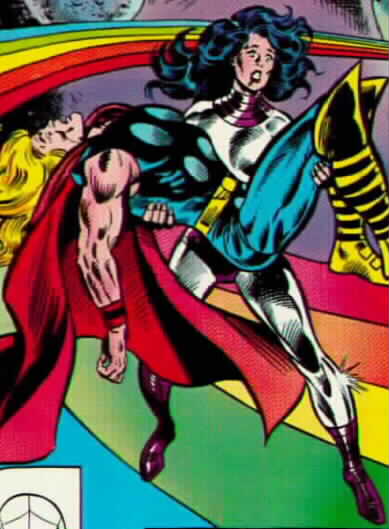
- However, Thor's attachment for Earth frequently came between them. Sif much preferred the world of the gods to the mundane world of mortals, and, after attempting to adjust to Earth life on more than one occasion, returned to Asgard to live without Thor. Once, when Thor's mortal paramour Jane Foster was dying, Sif lent her life force to revive the woman, "merging" with her in the process. She did this apparently in an attempt to understand Thor's attraction for this mortal. Jan Foster was separated from Sif shortly thereafter, and sent to the limbo-realm of the Runestaff of the Possessor. Sif and Thor have sinced rescued Foster. Sif and Thor both aided the alien champion Beta Ray Bill in defending his people against the onslaught of the demon armies of Surtur. Sif and Beta Ray Bill found themselves increasingly drawn to each other emotionally. Sif's relationship with Thor was greatly worsened when Thor, who was forced by enchantment to fall in love with the Asgardian Lorelei, struck Sif in anger. Sif even decided to leave Asgard and accompany Beta Ray Bill back to his people.
|
Goddess of the Harvest and Hunt
Briefly - Younger sister of Heimdall, Sif was once the goddess prophesied to wed the mighty Thor. Indeed, once betrothed to Odin's favorite son, she has relinquished her hold on Thor's heart to pursue other endeavors.(Source- Thor: the Legend)
The Marvel Handbook (1986) says:
Sif is a warrior goddess of Asgard and the sister of Heimdall, the watchman of Asgard. As a child she had golden hair and was an occasional playmate of Thor, son of Asgard's ruler Odin, and Thor's adoptive brother Loki.
While Thor and Sif were still adolescents, they fell in love with each other. Determined to ruin his hated adoptive brother's happiness by the ending the relationship between Thor and Sif, Loki cut off all of Sif's golden hair while she slept. Realizing Loki must have been responsible, Thor angrily confronted Loki and demanded that he restore Sif's hair. Loki sought out the dwarves Brokk and Eitri and asked that they create new hair for Sif through their arts. However, Loki was either unable or unwilling to pay the dwarves gold for this work. The dwarves decided that for the "price of naught" they would create "strands of naught." They magically created long black hair from the blackness of night. Once set upon Sif's head, the hair magically took root and began to grow. Thor thought Sif was even more beautiful with the black hair than she had been before, and thus Loki's plan to ruin their romance failed.
Eventually Thor and Sif parted when Sif began her training to be a warrior in earnest. Odin, lord of Asgard, had long deemed Sif to be a fitting mate for his son Thor. Just after Thor's relatively brief relationship with the mortal woman Jane Foster came to an end, Odin, hoping to turn Thor's feelings in a different direction, arranged for him to meet Sif once more. Sif was now highly accomplished in the ways of the warrior. Soon after meeting Sif again, Thor and Sif became lovers and companions, as well as allies in numerous battles. Eventually, they decided to marry.
However, Sif came to realize how deeply sorry Thor, who had been freed of Lorelei's enchantment, was for having struck her. Moreover, Sif finally fully realized that Lorelei was really to blame for Thor's striking her, and Sif was also greatly impressed by Thor's heroism in descending into the realm of the death goddess Hela to rescue the souls of Earth mortals. As a result, Sif finally accepted Thor's role as guardian of both Asgard and Earth, and decided to stay behind in Asgard while Beta Ray Bill returned to his people. Sif and Thor are once again linked by strong bonds of affection, but what path their relationship will next take remains to be seen.
|
|
Sigyn
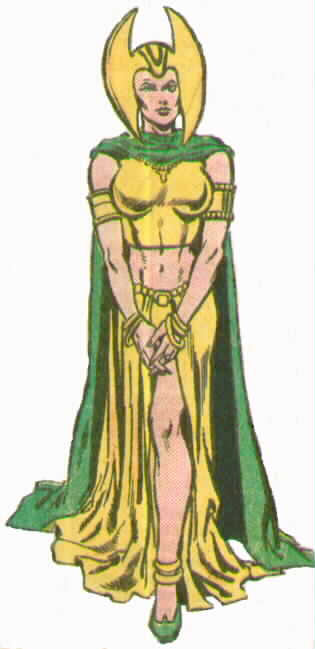
|
Goddess of fidelity
Briefly - Goddess of Fidelity. Tricked by Loki into marriage, Sigyn soon learned that being wife to the wickedest man in Asgard meant a life of neglect and abuse. But although fickle Loki has since released her from her marital vows, she will not forsake him as long as she believes he would be worse off without her.(Source- Thor: the Legend)
The Marvel Handbook (1986) says:
The circumstances of Sigyn's marriage to Loki has yet to be revealed. They were estranged for several centuries, and only recently has Sigyn tried to revive their marriage. Sigyn steadfastly aided Loki while he was being punished by Odin, but after Loki regained his freedom, he abandoned her.
|
|
Skurge, the Executioner
[no picture available]
- In recent years Loki, the evil foster brother of Thor, prince of Asgard, asked Amora to seduce Thor as part of one of Loki's schemes. Amora, disguised as an Earthwoman, went to Thor in his mortal persona of Dr. Donald Blake. Her efforts to seduce Blake failed, however. Outraged, Amora ordered Skurge to go to Earth and dispose of Jane Foster, the mortal nurse who worked for Blake and whom Thor then loved. Using his enchanted axe, the Executioner trapped Foster in another dimension. Then Skurge battled Thor himself, but finally made a bargain with Thor: he would return Foster to Earth in exchange for possession of Thor's enchanted hammer. Thor agreed to Skurge's terms and the Executioner brought Foster back to Earth. But then the Enchantress appeared, furious at Skurge's betrayal, and used her magic to punish him. Terrified, Skurge begged Thor for help and released him from their bargain. Thor reclaimed his hammer and used it to transport Amora and Skurge back to Asgard.
- Odin, monarch of Asgard, punished the Enchantress and the Executioner for their actions on Earth by exiling them there. On Earth the Enchantress and Executioner joined the original Masters of Evil, headed by Baron Heinrich Zemo, who sought vengeance on Thor and the other members of the mighty Avengers. Amora and Skurge aided Zemo in battling the Avengers several times. The Enchantress and the Executioner both escaped when the Masters of Evil met their defeat by the Avengers. Soon afterwards, Amora and Skurge were sent by Loki to capture Jane Foster. Thor's friend Balder the Brave arrived and fought Skurge, and the Executioner and the Enchantress fled without Foster when Thor himself appeared. Amora and Skurge later were among the many superhuman menaces assembled by Doctor Doom to attack the Fantastic Four on the day of the wedding of two of their members, Reed Richards and Susan Storm.
- The Executioner parted from the Enchantress and journeyed into an alternate future of the 25th century, where he was defeated by the Hulk, who had also traveled there through time. Returning to the time period he left, the Executioner was reunited with the Enchantress, and together they aided the Mandarin in an attempt at world conquest that was thwarted by the Avengers. Still later, the Enchantress and the Executioner led legions of trolls in an attempt to conquer Asgard itself. This attempt, however, was thwarted by the Hulk, whom Loki had transported to Asgard, and by Odin himself. Much later, the Enchantress and Executioner aided Loki in gaining the throne of Asgard, but Odin soon returned to power.
- Despite their past treason, the Enchantress and the Executioner nevertheless fought on the side of Asgard against the legions of Muspelheim when the latter realm's ruler, Surtur, attempted to destroy Asgard. Following the victory over Surtur and his hordes of followers, Amora and Skurge, both of whom had once been exiles from Asgard, lived there at peace with its inhabitants, at least to all appearances.
- Amora, however, turned her attention to winning Heimdall, sentry of Asgard, as a lover. Anguished at being avoided and ignored by Amora, Skurge approached the Enchantress while she was with Heimdall and told her he could not bear to be parted from he for so long. The Enchantress took the Executioner aside, and, as punishment for interrupting her while she was with Heimdall, magically turned Skurge's feet to tree trunks and rendered him mute.
|
Son of a giant and a goddess
Briefly -, Skurge was raised as a warrior in Asgard. His great prowess in slaying storm giants earned him the name "Executioner". In love with the treacherous Enchantress, he was frequently pitted against the god of thunder. He died a hero's death, however, battling the hordes of Hela, and now dwells in Valhalla.(Source- Thor: the Legend)
The Marvel Handbook (1986) says:
Skurge was the illegitimate son of one of the Frost Giants of the otherdimensional realm of Jotunheim and of a goddess who was born in Skronheim, a land on the Asgardian continent, which lies in yet another dimension. Ostracized by the Frost giants due to his diminutive size in comparison to them, Skurge turned against them. A great warrior, Skurge gained the epithet "The Executioner" through his prowess in killing many of the Storm Giants during one of the wars between Jotuheim and Asgard. Skurge was made a citizen of Asgard, but he chose to lead a solitary life there, in part due to his grim disposition, and in part because he did not feel himself truly accepted by the Asgardians as one of them.
Although Skurge found pleasure in exercising his skills as a warrior, the only real source of joy in his life was his passionate devotion to Amora the Enchantress, whose beauty is rivaled among Asgardian goddesses only by her sister, Lorelei. Amora was physically attracted to Skurge, who in effect became her love-slave. She never treated him as her equal and often withheld her favors from him in order to keep him in thrall, so he would do what she commanded in hope of ingratiating himself with her.
The effects of these spells soon wore off and Skurge returned to his normal condition, but he felt humiliated and betrayed by Amora. In deep emotional pain, and believing Amora to have faithlessly deserted him for Heimdall, Skurge sought to find solace in turning him attention to battle. Therefore, the Executioner volunteered to join his past enemy Thor and the Einherjar (the warriors of Valhalla) in their expedition to Hel, the realm of Hela, the death goddess. Through the machinations of Malekith the Accursed, ruler of the Dark Elves, the souls of various mortals from Earth had been separated from their bodies and sent to dwell in Hel. Thor was determined to rescue these souls and restore them to their living bodies.
Within Hel the Executioner believed he saw the Enchantress, who claimed that she had been killed, and that she loved Skurge passionately and wanted him to stay in Hel with her for eternity. But when Balder, who had also accompanied Thor to Hel, pointed out that the "Enchantress" Skurge saw there was not what she seemed, Skurge used his enchanted axe to destroy the illusion, revealing the seeming Enchantress to be Mordonna, a pawn of Hela. Hela then tried to persuade Thor that the Executioner was in league with herself. Then Hela declared that Skurge would sail with her warriors, the spirits of the damned, aboard the ship called the Naglfar, which had taken millennia to build, to conquer Asgard. Infuriated at thus being manipulated by Hela and Mordonna, the Executioner refused to serve the death goddess and used his enchanted axe to cleave through the dimensions, thereby releasing titanic energy that destroyed the Naglfar. In the process Skurge's axe was also destroyed.
Thor, Balder, the Executioner, the Einherjar, and the rescued mortal souls left along the Helway, the path leading out of Hel, with Hela's forces in pursuit. Thor and his party finally reached Gjallerbru, the golden bridge spanning the river Gjoll, the boundary that marks the end of Hela's domain. Thor declared that he himself would remain behind to hold off Hela's hordes while the others escaped. But the Executioner then knocked Thor down from behind, rendering him unconscious.
Skurge then told Balder that everyone -- including Hela, Mordonna, and the Enchantress, except for the kind Balder himself -- laughed at him, causing him great pain. Skurge said he felt as if perhaps he died a little each time he was laughed at, and that now it was as if he were already dead. Therefore, Skurge asserted, he himself would stay behind to face Hela's legion, "and the last laugh will be mine." Balder consented to Skurge's wish. Taking the unconscious Thor with them, Balder, the Einherjar, and the rescued mortal souls left.
Skurge remained alone at Gjallerbru, armed with automatic weapons that the Einherjar had brought from Earth. When Hela's forces arrived, Skurge singlehandedly held them off as long as he was able, and not one of his opponents set foot upon the bridge. Ultimately, Skurge perished heroically in the great battle.
Perhaps to the surprise of many, the Enchantress was torn by sorrow upon learning of Skurge's demise. Hela finally sent Skurge to Valhalla, where heroic Asgardian warriors go after death, and, fulfilling their promise to him, Balder and Thor drank a toast to Skurge's memory.
|
|
Tyr
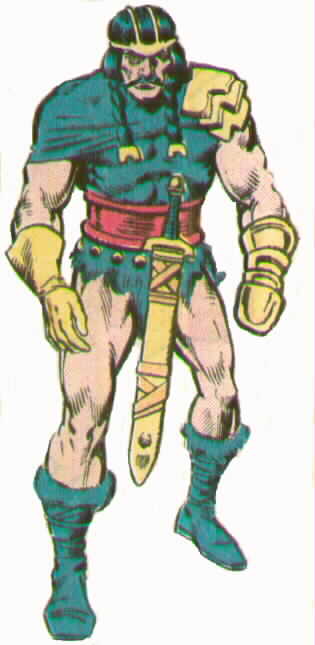
|
God of War
Briefly -God of War. Before Thor was born, the eldest son of Odin aided his father in the binding of the savage Fenris wolf, and lost his hand doing it! Tyr has long resented the other gods for the sacrifice he made, and since Thor's birth, that resentment has focused on Odin's favorite son, the thunder god.(Source- Thor: the Legend)
The Marvel Handbook (1986) says:
Before Thor was born, Tyr had been a valiant defender of Asgard who lost his hand binding the wolf-god Fenris. Bitter about Thor's preeminence, Tyr has engaged in rebellion against Odin. He recently fought for Asgard against Surtur.
|
|
Vidar
[no picture available]
|
God of Strength
Briefly - Son of Odin and a giantess named Grid, Vidar was banished from Asgard when Odin wed the goddess Frigga. Becoming a skilled huntsman in the mountains of Asgard, the grim god vowed never to set foot in the city of his father again, a vow he has broken but once in a millennium. (Source- Thor: the Legend)
The Marvel Handbook (1986) says:
The product of Odin's dalliance with a giantess, Vidar lived outside the city of Asgard, his existence known to a few. He ventured into the city but once to seek the redress for the slaying of his wife.
|
|
Volla
[no picture available]
|
Prophetess
Briefly - The aged goddess of prophecy. Born of the race of enchanters called the Norns, she now resides in Hel, the land of shades, where she is one of Hela's closest advisors. Though Volla is a gifted seer compelled to speak the truth, only the bravest of the living dare to seek her counsel.(Source- Thor: the Legend)
The Marvel Handbook (1986) says:
Volla died after making known her prophecies of Ragnarok, but those who are brave and powerful enough to journey into the realm of the dead may still obtain prophecies from her.
|
|
Volstagg
|
The Lion of Asgard
Classic Quote: "Though the unmatched strength of Volstagg shall soon shatter these ignoble chains... who knows what words would flow... if my tongue were loosened by a tankard of cold ale! A desperate strategem... but one which is surely not beyond such crafty foes as thee!"
The Marvel Handbook (1986) says:
Volstagg is a member of the Warriors Three, three of Asgard's most celebrated heroes. Hogun, Fandral and Volstagg are longtime friends who ususally work together as a team. Their first known mission together took place at an unknown time in the past when they joined the quest by sea led by the prince of Asgard, Thor, to discover the reason why a crack had appeared in the Odinsword (also called Oversword) of Asgard, a power object that could bring about Asgard's destruction. Hogun, Fandral, and Volstagg aided Thor in quelling a mutiny led against Thor, on this mission by his adoptive brother Loki. Since then Hogun, Fandral, and Volstagg have been Thor's friends, allies, and companions, and have aided him in numerous exploits.
Volstagg is older than his two companions, and is rumored to have been one of Asgard's greatest warriors in his youth. Volstagg and his wife Gudrun are raising an enormous family, of whom the best-known member is their spirited daughter Gunnhild ("Hildy"). Recently Volstagg adopted two children from Earth, Kevin and Mick, the orphaned sons of a woman named Ruby, who was killed by Thor's enemy, the Zaniac. Volstagg is motivated to join Hogun and Fandral in exploits both by a love of adventure and by a need to get away from his large family (who he nonetheless deeply loves) from time to time. Although Volstagg's boastfulness about his battle prowess is sometimes belied by his occasional clumsiness, he remains a far more formidable opponent than his appearance would suggest.
Like other Asgardians, the Warriors Three are extremely long-lived (although not immortal like the Olympian gods), superhumanly strong, immune to all terrestrial diseases, resistant to convential injury, and in possession of superhuman endurance.
|
|














